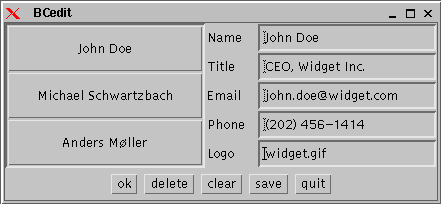
Anders Møller and Michael Schwartzbach, February 2006

|
NOTE:
These slides have not been updated since 2003. They have been superseded by the book
Anders Møller and Michael Schwartzbach, February 2006 |
|
| THE XML REVOLUTION - TECHNOLOGIES FOR THE FUTURE WEB |
|
<cards>
<card>
<name>John Doe</name>
<title>CEO, Widget Inc.</title>
<email>john.doe@widget.com</email>
<phone>(202) 456-1414</phone>
<logo url="widget.gif" />
</card>
<card>
<name>Michael Schwartzbach</name>
<title>Associate Professor</title>
<email>mis@brics.dk</email>
<phone>+45 8610 8790</phone>
<logo url="http://www.brics.dk/~mis/portrait.gif" />
</card>
<card>
<name>Anders Møller</name>
<title>Research Assistant Professor</title>
<email>amoeller@brics.dk</email>
<phone>+45 8942 3475</phone>
<logo url="http://www.brics.dk/~amoeller/am.jpg"/>
</card>
</cards>
|
We then write a Java program to edit such collections.
First, we need a high-level representation of a business card:
class Card {
public String name, title, email, phone, logo;
public Card(String name, String title, String email, String phone, String logo) {
this.name = name;
this.title = title;
this.email = email;
this.phone = phone;
this.logo = logo;
}
}
|
An XML document must then be translated into a vector of such objects:
Vector doc2vector(Document d) {
Vector v = new Vector();
Iterator i = d.getRootElement().getChildren().iterator();
while (i.hasNext()) {
Element e = (Element)i.next();
String phone = e.getChildText("phone");
if (phone==null) phone="";
Element logo = e.getChild("logo");
String url;
if (logo==null) url = ""; else url = logo.getAttributeValue("url");
Card c = new Card(e.getChildText("name"), // exploit schema,
e.getChildText("title"), // assume validity
e.getChildText("email"),
phone,
url);
v.add(c);
}
return v;
}
|
And back into an XML document:
Document vector2doc() {
Element cards = new Element("cards");
for (int i=0; i<cardvector.size(); i++) {
Card c = (Card)cardvector.elementAt(i);
if (c!=null) {
Element card = new Element("card");
Element name = new Element("name");
name.addContent(c.name);
card.addContent(name);
Element title = new Element("title");
title.addContent(c.title);
card.addContent(title);
Element email = new Element("email");
email.addContent(c.email);
card.addContent(email);
if (!c.phone.equals("")) {
Element phone = new Element("phone");
phone.addContent(c.phone);
card.addContent(phone);
}
if (!c.logo.equals("")) {
Element logo = new Element("logo");
logo.setAttribute("url",c.logo);
card.addContent(logo);
}
cards.addContent(card);
}
}
return new Document(cards);
}
|
A little logic and some GUI then completes the editor:

Compile with: javac -classpath xerces.jar:jdom.jar BCedit.java
This example contains some general observations:
|
| COPYRIGHT © 2000-2003 ANDERS MØLLER & MICHAEL I. SCHWARTZBACH |
|